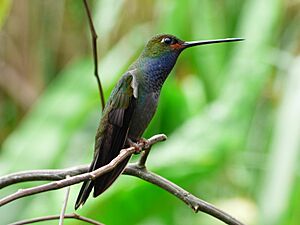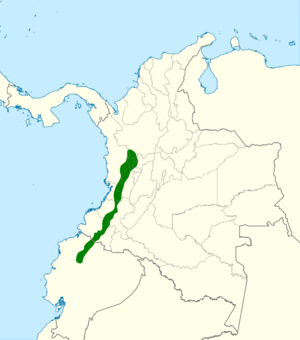Rufous-gaped hillstar facts for kids
Quick facts for kids Rufous-gaped hillstar |
|
|---|---|
 |
|
| Conservation status | |
| Scientific classification | |
| Genus: |
Urochroa
|
| Species: |
bougueri
|
 |
|
The rufous-gaped hillstar (Urochroa bougueri) is a type of hummingbird. It used to be considered part of the "white-tailed hillstar" group. You can find this bird in Colombia and Ecuador.
Contents
About the Rufous-Gaped Hillstar
This section explains how scientists classify the rufous-gaped hillstar and how it got its name.
How it Got its Name
The rufous-gaped hillstar was first officially described in 1851. A French bird expert named Jules Bourcier found a specimen in Ecuador. He gave it the scientific name Trochilus bougueri. Later, in 1856, another expert, John Gould, placed it in a new group called Urochroa.
The name Urochroa comes from ancient Greek words. Oura means "tail" and khroa means "color." The second part of its name, bougueri, honors a French mathematician named Pierre Bouguer. He visited Peru a long time ago.
Family Tree
The rufous-gaped hillstar and the green-backed hillstar (Urochroa leucura) are the only two birds in their group, Urochroa. They were once thought to be the same species. Even though they share the name "hillstar" with birds from another group called Oreotrochilus, they are not closely related. The rufous-gaped hillstar is a unique species, meaning it does not have different subspecies.
What Does the Rufous-Gaped Hillstar Look Like?
This hummingbird is about 13 to 14 cm (5.1 to 5.5 in) long. This includes its bill, which is about 3 cm (1.2 in) long. It weighs between 8.5 and 12.5 grams (0.30 to 0.44 oz). Both male and female birds look alike.
They have a long, straight, black bill. Their upper body is a shiny coppery green color. The name "rufous-gaped" comes from the reddish-brown streak on their face, near their cheeks. Their throat and chest are a bright, shimmering blue. Their belly is a dull gray. The feathers in the middle and on the very outside of their tail are black. The other tail feathers are white with dark gray edges. Young birds look similar to adults, but they have some light brown edges on their head feathers.
What Sounds Does it Make?
Scientists believe the rufous-gaped hillstar's song is a continuous series of single "swit" or "tsit" notes. When it is alarmed, it makes a liquid "twit" sound, repeating it many times.
Where Does the Rufous-Gaped Hillstar Live?
The rufous-gaped hillstar lives on the Pacific side of the Andes mountains. You can find it from Colombia's Chocó Department south into Ecuador, as far as Pichincha Province.
Habitat and Elevation
This bird prefers to live inside and at the edges of old montane forests. It also lives in newer forests that have grown back, and on shrubby hillsides. You can often find it near streams. It usually lives at elevations between 1,600 and 2,800 meters (5,200 and 9,200 ft) above sea level. It is most common around 1,800 meters (5,900 ft). Sometimes, it can be found much lower than its usual minimum elevation.
The rufous-gaped hillstar generally stays in one area. However, in Colombia, it moves to different elevations depending on the season.
Behavior of the Rufous-Gaped Hillstar
Hummingbirds have interesting ways of finding food and raising their young.
Feeding Habits
The rufous-gaped hillstar usually looks for food in the lower and middle parts of the forest. Sometimes, it will go up to the very top of the trees. Male birds protect areas where there are many flowering plants.
It mostly drinks nectar from plants like Inga, Bomarea, Psammisia, and Cavendishia. Besides nectar, it also catches small insects. It does this by flying out from a perch to snatch insects in the air, a behavior called "hawking."
Reproduction and Life Cycle
In Colombia, the rufous-gaped hillstar's breeding season is from December to March. Its breeding habits in Ecuador have not been studied yet.
The female bird builds a cup-shaped nest. She uses moss and lichen for the nest. It is usually built on a vertical branch, about 8 to 12 meters (26 to 39 ft) high in a tall tree. The female sits on two eggs for 16 to 18 days. The young birds leave the nest 23 to 25 days after they hatch.
Conservation Status
The IUCN (International Union for Conservation of Nature) has listed the rufous-gaped hillstar as a species of Least Concern. This means it is not currently considered to be at high risk of extinction. However, we don't know the exact size of its population or if it is growing or shrinking.
No immediate threats to this bird have been found. It is considered uncommon to rare in Ecuador. In Colombia, it is fairly common. It lives in at least two protected areas in Colombia, which helps keep its habitat safe.


